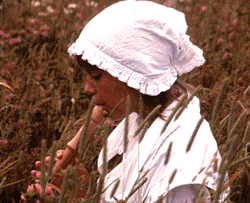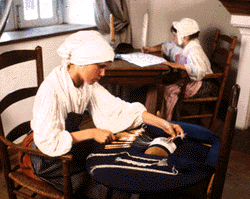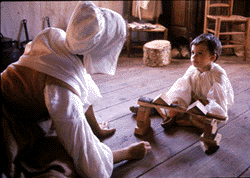
Children of 18th-Century Louisbourg
 In today's Canadian society, children are highly valued individuals who bring joy into the lives of parents. However, children in the 18th century, known as "petits sauvages", were not significant figures. A l728 dictionary defined "enfant" as a son or daughter who owed his or her birth to another individual of maternal and paternal relationship. In an atmosphere of war, exile, and famine, these miniature adults lived simple lives until the age of seven when they joined the workforce.
In today's Canadian society, children are highly valued individuals who bring joy into the lives of parents. However, children in the 18th century, known as "petits sauvages", were not significant figures. A l728 dictionary defined "enfant" as a son or daughter who owed his or her birth to another individual of maternal and paternal relationship. In an atmosphere of war, exile, and famine, these miniature adults lived simple lives until the age of seven when they joined the workforce.
Children's Clothing
Games
According to the French law, the Coûtume de Paris, young boys and girls did not maintain civil rights until the age of twenty-five; the age of maturity. Once an individual reached this age, he or she could inherit property, purchase goods, and initiate legal proceedings. Boys or girls under twelve or fifteen years of age, respectively, were referred to as "enfants". But, once they reached twelve or fifteen years old, they could get married, pending parental consent. Marriage emancipated an individual from the legal disabilities of remaining a minor; however, the social and legal benefits of married life still did not influence a surge of early marriages. An individual was not regarded as a child anymore, yet still was not received into the institution of adulthood even though they assumed adult responsibilities before the age of majority.
An integral component in the learning process was the development of religious and moral principles in young girls and boys. In the Old World, the catholic church was responsible for formal education. In New France, however, the royal officials provided the funding for schools. Children were required to learn their catechism and rules and regulations of Catholicism before taking their first communion and confirmation. They would frequently pray in French and attend masses in Latin. Religion dictated the livelihood of individuals in Louisbourg. Therefore, one needed to obey the laws of the church (Canon Law) in order to pass through the rites of passage into the community. For instance, the church forbid parents to permit their boys and girls to share the same bed after seven years of age. Aside from religion, a child would be involved in many recreational activities such as games and crafts.
Interestingly, children under the age of seven were dressed as little adults. Girls and boys clothes were not distinguishable from one another. Privileged children, from age seven onward, would wear complete suites of clothing and the latest fabrics or designs. Despite the growing population of
 child labour, no member of the elite would permit his/her child to enter domestic service as a servant-junior officer, etc. Young boys who came from well-to-do households were often sent to Quebec or France to be educated. They also might have chosen private tutoring at home by professional tutors who were educated soldiers. Most of the upper class girls would be educated by the sisters of the Congregation of Notre-Dame. The Sisters' mission was to instruct young girls in the Christian religion; teach them reading, writing, needle-work, and other female accomplishments.
child labour, no member of the elite would permit his/her child to enter domestic service as a servant-junior officer, etc. Young boys who came from well-to-do households were often sent to Quebec or France to be educated. They also might have chosen private tutoring at home by professional tutors who were educated soldiers. Most of the upper class girls would be educated by the sisters of the Congregation of Notre-Dame. The Sisters' mission was to instruct young girls in the Christian religion; teach them reading, writing, needle-work, and other female accomplishments.
 Children of influential parents, such as bourgeois merchants, administrators or senior officers, often intermarried. Girls brought considerable dowries into their marriages. Marriage was a means to wealth and influence, and these extended kinships generated feelings of local identity.
Children of influential parents, such as bourgeois merchants, administrators or senior officers, often intermarried. Girls brought considerable dowries into their marriages. Marriage was a means to wealth and influence, and these extended kinships generated feelings of local identity.
Children of impoverished parents were easily identified. They had poorer quality of clothing which might have been tattered and worn, usually owning only one or two changes of clothing. These children lived in unsanitary living conditions and substandard housing. Their diets were sparse and some children suffered malnutrition. There was a high rate of illiteracy since a majority of these children had little or no formal education. Lower class boys received no private tutoring unless employed in the Governors wing. These boys would be apprenticed at the age of seven and placed on the payroll at approximately age twelve. They might have gained some writing skills; however, they would usually receive training in areas of carpentry, fishing, etc. Lower class girls would most likely adopt many of the female roles carried out by her mother. They could not afford to attend the school taught by the Sisters; however sending them to other households to perform domestic service was a type of apprenticeship and education. Few girls would marry at approximately twelve and thirteen years of age. They brought little or no dowry into a marriage. Thus, the inferior clothing and inadequate housing indicated children's class structure.
Young children were not recognized for their hard work at an early age. Children who were domestic servants, slaves, apprentices, and fishermen were classified according to occupation in the Louisbourg census. Thus, the census failed to recognize that a proportion of Louisbourg's workforce were labouring children. The attention our society devotes to children today was not evident in this French community.


